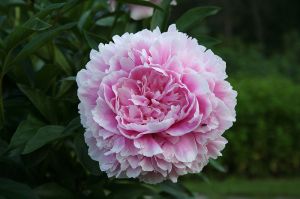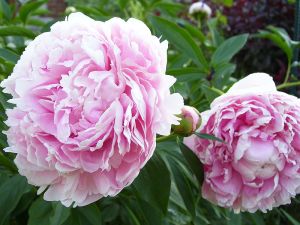Native to China, these are some of the most gorgeous flowering plants I’ve encountered. The flowers of ‘Sarah Bernhardt’ are double flowers (making them much larger) and monoecious (making them easier to pollinate). They can be left alone for years at a time and aren’t particularly fond of being transplanted. The foliage is attractive and colorful, although often home to hungry ants. Ants typically “invade” peonies while their flower buds develop due to the abundance of nectar present. They show up so frequently that some thought that they were required to open the flowers. The ants are, for the most part, harmless though.
Although I’ve seen these all my life, I only recently discovered what they were. These have been left alone in my yard for years, at least before I took a deep interest in them. It is true that ants adore these, and they typically require some care to remain healthy over the years (or any care for that sake). Although not openly stated, I’m inclined to believe that they are drought tolerant. The ones close to me have been around for quite some time and were neglected from manual watering until about last year. Weekly watering and removing the foliage once it dies off helps overall health.
Paeonia lactiflora ‘Sarah Bernhardt’ (Peony)
Deciduous: yes
Hardiness Zones: 3-8
Height: 2.5-3.0 feet tall
Diameter: 2.5-3.0 feet spread
Growth Rate: fairly slow
Age: perennial, typically up to 50 years, sometimes up to 100 years
Root System: Not too extensive, primarily consists of a crown. The roots are sometimes used in “Four Things Soup” in China as a “woman’s tonic”. The roots are occasionally used to help with stomach problems, ulcers, fevers, and various other medicinal issues. When the entire root is harvested at once, it is called “Chi Shao Yao”.
Family: Paeoniaceae
Subspecies: ‘Sarah Bernhardt’ among many others
Tolerates: rabbits and deer, mostly pest resistant, being left alone for a significant duration of time
Problems (major): Borytis mold, a type of fungus, is the most common ailment to peonies. This produces a gray mold on flowers and dark blotches on leaves.
Problems (minor): Botrytis blight, Phytophthora blight, strong rain can force entire plants to the ground, peony wilt, honey fungus, and bud eelworms. Will not flower if recently transplanted into a slightly different soil depth.
Poisonous: Consumption leads to indigestion and stomach pains.
Soil requirements: Rich, fertile, well-drained preferred; grow in normal, sandy, or clay (preferred) soils with a pH of 6.0-7.0 (slightly acidic to neutral). To ensure flowering, place the crown around 2 inches below the soil’s surface (transplating is best done in October, once these plants have gone dormant).
Air Requirements: not sufficiently researched (I have yet to be find anything regarding pollution tolerance or humidity preferances.)
Watering requirement: medium
Sun requirement: full sun or part-shade
Leaf shape: dark green, somewhat lanceolate to oblong
Leaf size: The stems grow up to 90 centimeters (3 feet) tall, presumably no more than 4 inches in length and 1 inch in width
Flower structure: Blossoms are double flowers (the carpels and stamens are entirely changed into petalodes, the guard petals do not distinguish between these). The flowers are fairly enormous (up to 6 inches across), a sweet pink color, and are very fragrant. Ants are frequently attracted to the opening flowers due to high nectar concentration along the flowers.
Flowering frequency: Flowers in May and June
Bulb/tuber: crowns (contain pink buds (“eyes”) on top)
Monocot/Dicot: dicot
Annual/Biennial/Perennial: perennial
Notable characteristics:
Annual fertilization of 10-10-10 or 12-12-12 mixes improves growth once these are a few years old. Ants frequently visit peonies, especially when they are preparing to flower, although they do almost no harm to the plants. Although picky about planting depth, peonies are surprisingly fine with being left alone for years at a time (maintenance does help, though).
Uses:
The roots are sometimes used for medicinal purposes (primarily in China). These are frequently grown for their outstanding flowers and attractive foliage.
Sources used:
- http://www.pfaf.org/user/Plant.aspx?LatinName=Paeonia+lactiflora
- http://www.peony.co.il/page.asp?id=30
- http://www.weekendgardener.net/perennial-flowers/plantpeony-100810.htm
- http://www.missouribotanicalgarden.org/PlantFinder/PlantFinderDetails.aspx?kempercode=q400
- http://apps.rhs.org.uk/plantselector/plant?plantid=1371
- http://www.perennials.com/plants/paeonia-lactiflora-sarah-bernhardt.html
- http://www.pnwplants.wsu.edu/PlantDisplay.aspx?PlantID=659
- http://www.hort.purdue.edu/ext/ho-76.pdf
- http://plants.usda.gov/core/profile?symbol=PALA27
- http://www.uaex.edu/yard-garden/resource-library/plant-week/peony.aspx
- http://acreage.unl.edu/peony
A full double-flower Peony in bloom (uploaded 9 July 2006)
Full double-flowers, buds, and foliage all present on P. lactiflora ‘Sarah Bernhardt’ (Uploaded 15 June 2007 by Mike Bowler)
I do not own the rights of these images; all credit goes to its original creator(s).


